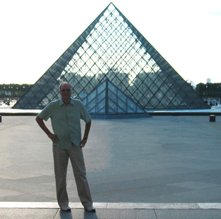[box]Richard Merrick[/box]
Richard Merrick has dedicated his life to blending science, technology and art into innovative digital media experiences and exciting new forms of communication.
As founder and CEO of Postfuture, a pioneering rich-media communications provider for Best Buy and Microsoft, he led the company to become the 4th fastest growing hi-tech company in Texas. Prior to this, he was the technology founder and later CEO of 7th Level, a global CD-ROM game publisher and Internet technology company known for such award-winning titles as TuneLand Starring Howie Mandel and Monty Python’s The Quest for the Holy Grail.
Merrick’s work spans diverse areas of digital media, including search engines, graphics operating systems, multimedia applications, interactive games, voice-response Web agents and dynamically personalized Internet communications. Because of this, he has been invited to speak around the world on the future of digital media and cited as an expert in leading publications.
Outside of technology, he is a jazz pianist and composer, an artist in oils, writer and independent researcher. He received his B.A. (magna cum laude) and M.S.C.S. degrees from the University of Texas – Dallas.
For more information about the author visit his Linkedin.com profile or Facebook page. To send comments or schedule a speaking engagement, contact Richard by clicking on the e-mail link at the bottom of this page.
[author] [author_image timthumb=’on’]http://www.sciencetosage.com/wp-content/uploads/2011/05/Screen-shot-2011-05-26-at-12.31.28-AM.png[/author_image] [author_info]Harmonic Interference Theory is a set of thirty-four principles that explain music perception using the underlying physics of a harmonic standing wave. Based on a mathematical balance between maximum resonance and damping geometries in geodesic space, perceptual qualities in music can be modeled simply and organically using a “reflective interference function” between the harmonic and Fibonacci series. This is then used to explain how musical timbre and harmony are pattern matched recursively as cymatic patterns in the ear and brain. [/author_info] [/author]
[author] [author_image timthumb=’on’]http://www.sciencetosage.com/wp-content/uploads/2011/05/Screen-shot-2011-05-26-at-12.32.22-AM.png[/author_image] [author_info]Harmonic Evolution is the missing link in Darwin’s Origin of the Species. Recent studies on the mesoscopic structures of water and carbon, together with the latest geometric DNA mapping theories, suggest that life emerges and grows according to predictable harmonic patterns found in organic chemistry, preserving and propagating specific atomic geometries into living organisms. Based on this and the latest neurophysiological research, a harmonic Gaussian interference model for cellular entrainment is presented to explain the origin of common organic geometries, including cardioid, ellipsoid and spiral primitives, as well as 3-fold exo- and 5-fold endo-skeleton structures. From this, a recursive harmonic Hilbert space is defined for use in evolutionary classification, physiological analysis and organic simulations. Examples are provided, including a step-wise analysis of the human body. Avenues for additional research are discussed, including application of harmonic Gaussian interference models to cosmology, cognition, medicine, social theory and philosophy.[/author_info] [/author]
[button link=”http://www.interferencetheory.com” color=”silver” newwindow=”yes”] Official Website[/button]
[button link=” http://www.interferencetheory.com/index.html” color=”teal” newwindow=”yes”] Book Link[/button]
Articles – http://www.interferencetheory.com/Articles/Articles.html

